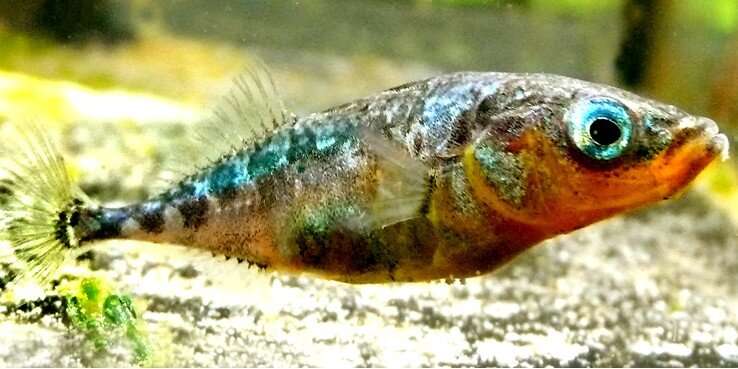Infection by parasites disturbs flight behaviour in shoals of fish

In order to escape predators, many fish—including insects, fish and birds—have developed strategies for rapidly transmitting information on threats to others of their species. This information is transmitted within a group of hundreds, or even thousands, of individuals in 'escape' waves. This collective response is also, in the case of fish, known as shoal behavior. Special parasites can, however, manipulate such a survival strategy. Researchers at the University of Münster have discovered that infected individual fish disturb the transmission of flight behavior and, as a result, increase not only their own risk of being eaten, but also that of other—non-infected—members of the group. The results of the study have been published in the journal Proceedings of the Royal Society B.
Background and methodology
In order to study social responsiveness in fish, the researchers used the tapeworm Schistocephalus solidus as a parasite. The three-spined stickleback Gasterosteus aculeatus—an important model in ecological and evolutionary parasitology—was used as an intermediate host. The parasite ensures that the fish is less prone to be scared and more courageous and, as a result, increases its risk-taking behavior. This poses the threat that the stickleback will very probably fall prey to the final host of the parasite, a fish-eating bird. In aquariums the scientists simulated a bird strike on shoals of sticklebacks. "When the shoal consisted only of healthy—in other words, non-infected—sticklebacks, the escape wave continued quickly through the entire shoal after the bird strike, even though the sticklebacks at the back were only able to see the response of their conspecifics and not the bird strike itself," explains Nicolle Demandt from the Institute of Evolution and Biodiversity at the University of Münster and lead author of the study. "When we placed infected sticklebacks in the middle of the shoal, the escape wave came to a virtual halt and it only got through to the fish at the back to a limited extent."
Although the manipulation of behavior on the part of parasites is widespread in the animal kingdom, many studies carried out so far have only concentrated on the infected animals themselves and on the manipulation of their behavior. "Ours is the first experimental study which shows how individuals whose behavior has been manipulated by parasites can influence the transmission of information and, as a result, collective flight responses—in other words, shoal behavior," explains Prof. Joachim Kurtz, in whose laboratory the study was carried out. The researchers examined the connection between parasitic infection and flight depth, as well as the time the fish spent in the danger zone before and after the bird strike.
Sticklebacks with a high parasitic infection displayed a tendency to take flight to not such a deep level and they remained in the danger zone for a longer period of time than did sticklebacks with less parasitic infection. "The result indicates that the loss of energy might play a role in the extent to which behavior is manipulated," explains Dr. Jörn Scharsack, who led the study. "Parasites remove energy from their hosts, which leads for example to a reduction in fat reserves and a higher food requirement. Infected fish should therefore invest less energy in flight response and return more quickly to looking for food."
As sticklebacks are found in very different aquatic systems—e.g. clear lakes, turbid rivers and sea environments—transferring the results of the study to the fishes' natural habitats depends on the local surroundings. In clear waters, the results can indeed be transferred to the natural habitat as the fish use their eyes to react to the signals from other sticklebacks taking flight. In more turbid surroundings, however, the fish can rely more on other senses. For example, by means of their lateral line organs they can feel even the smallest changes in pressure caused by the movements made by their neighbors in the shoal. Other factors influencing the transfer of the laboratory study to a natural environment are the size of the shoal, the number of infected individuals and the extent of their parasitic infection.
Should it be a general phenomenon that infected individuals have an influence on the collective responses of the entire group, this might be of wide-ranging significance for the animal kingdom—even including a possible influence of parasites on human group behavior, say the researchers.
More information: Nicolle Demandt et al, Parasite infection disrupts escape behaviours in fish shoals, Proceedings of the Royal Society B: Biological Sciences (2020). DOI: 10.1098/rspb.2020.1158
Journal information: Proceedings of the Royal Society B
Provided by University of Münster




















